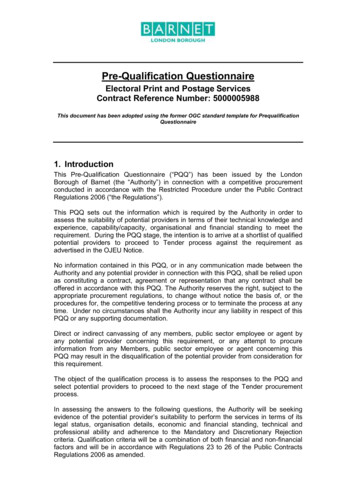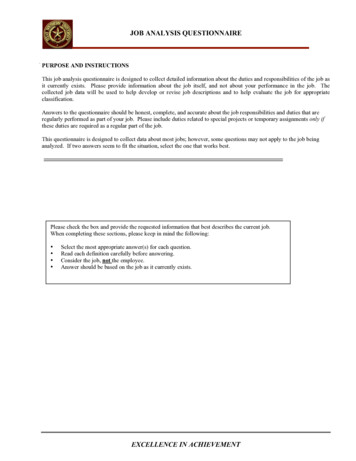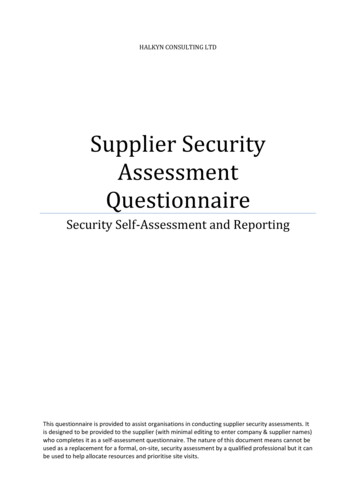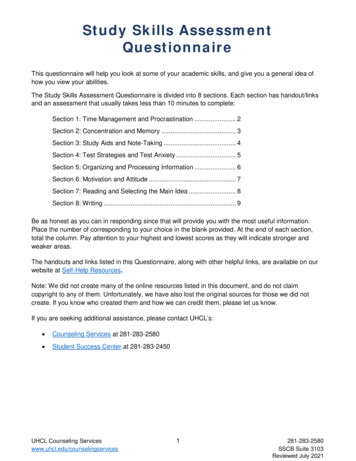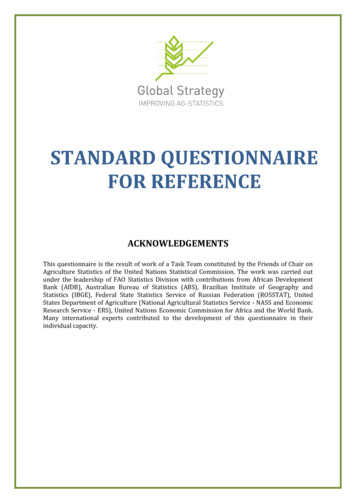
Transcription
STANDARD QUESTIONNAIREFOR REFERENCEACKNOWLEDGEMENTSThis questionnaire is the result of work of a Task Team constituted by the Friends of Chair onAgriculture Statistics of the United Nations Statistical Commission. The work was carried outunder the leadership of FAO Statistics Division with contributions from African DevelopmentBank (AfDB), Australian Bureau of Statistics (ABS), Brazilian Institute of Geography andStatistics (IBGE), Federal State Statistics Service of Russian Federation (ROSSTAT), UnitedStates Department of Agriculture (National Agricultural Statistics Service - NASS and EconomicResearch Service - ERS), United Nations Economic Commission for Africa and the World Bank.Many international experts contributed to the development of this questionnaire in theirindividual capacity.
Logo of AgencyCOUNTRY ASSESSMENT OFAGRICULTURAL STATISTICS SYSTEMFor implementation of theGLOBAL STRATEGYTO IMPROVE AGRICULTURAL AND RURAL STATISTICSReference YearCountry NameCountry CodeRegion CodeName:Title and Institution:Focal Point for CoordinationEmail:(in the Country)Phone - Mobile:Phone – Office:Name:Institution:FAO Contact PersonEmail:Phone :Deadline for Submission of theQuestionnaireTo:Email Address for SubmissionCc:Date of submission2
TABLE OF CONTENTSINTRODUCTIONRESPONDENT DETAILSTo be filled bySECTION 1: INSTITUTIONAL ENVIRONMENT1.1Administrative structure of the countryFAO Focal Point1.2 Legal and administrative framework for the collection ofstatisticsFAO Focal Point1.3Structure of the National Statistical SystemFAO Focal Point1.4Strategic frameworkFAO Focal Point1.5Dialogue with data usersFAO Focal PointSECTION 2: CORE DATA AVAILABILITY2.1Availability and coverage of agricultural statisticsFAO Focal PointSECTION 3: MAIN STATISTICAL ACTIVITIES3.1 Population CensusNSO3.2 National Accounts StatisticsNSO3.3 Adoption of classificationsNSO3.4 Price IndicesNSO & Line Ministries3.5 Food and Agricultural Surveys ConductedNSO & Line Ministries3.6 Household Budget SurveyNSO3.7 Availability of derived statistics and indicators in thecountryNSO & Line Ministries3.8 Quality consciousness in statisticsNSO & Line Ministries3.9 Information technologyNSO & Line Ministries3.10 Transport InfrastructureNSO & Line Ministries3.11 Financial resourcesNSO & Line Ministries3.12 Human resources and training for statistical activitiesNSO & Line Ministries3.13 International cooperation in agricultural statisticsNSO & Line MinistriesSECTION 4: CRITICAL CONSTRAINTS IN AGRICULTURE STATISTICS SYSTEM4.1Critical constraintsNSO & Line Ministries4.2Any other commentsNSO & Line Ministries4.3Abbreviations usedNSO & Line Ministries3
INTRODUCTIONOBJECTIVE OF THE ASSESSMENTThe Food and Agriculture Organization of the United Nations (FAO) has a mandate to provideglobal assessments, statistics and analyses on the situation of food and agriculture sector to theinternational community. Thus FAO’s implicit role is also to support the efforts of membercountries in developing their statistical systems to be able to meet the national andinternational demand for reliable statistics.In collaboration with international partners, FAO has prepared a Global Strategy to ImproveAgricultural and Rural Statistics. The strategy aims at developing country capacity to be able toprovide a minimum set of core indicators on agriculture. This goal will be achieved throughmainstreaming of agriculture statistics into national statistical systems, and by establishing anintegrated framework of surveys and data bases, including those on agriculture sector through anational strategy or plan for improving agriculture statistics. The national efforts will besupported by a Global and Regional Action Plans comprising of Training, Research andTechnical Assistance activities.The implementation of the Strategy at the country level will start with an assessment work ineach country, which will help grouping countries according to the stage of development of theirstatistical systems. In each country the country assessment will also point out towards weakareas in the statistical system for agriculture and rural development for priority attention.The present questionnaire, developed through an international collaborative process, is the firststep towards the assessment of the state of National Agricultural Statistical System. The report,to be prepared on the basis of the data gathered through the questionnaire, will highlight areasof strengths and weaknesses in national systems. The areas thus identified would be useful indesigning cooperation programmes (between countries or with international agencies). Thereports of the assessments will serve as advocacy tool for national statistical offices. Missionsfor carrying out in-depth assessments will be undertaken in the priority countries identified, onthe basis of information collected through this questionnaire. The findings andrecommendations of these missions will provide the basis to create a national strategy/plan toimprove agriculture and rural statistics.The questionnaire is expected to be used as a standard international reference document forcreating comparable country profiles and ranking countries according to level of their statisticaldevelopment. The result of periodic “Country Assessments” carried out using the same standardquestionnaire will serve as monitoring and evaluation tool for measuring progress achieved inthe development of agriculture statistics during the course of the implementation of the GlobalStrategy.This questionnaire represents the commons core for all countries and all regions. The regionshave the liberty to adapt this questionnaire to suit the local requirements and situations.4
BACKGROUND AND SCOPE OF THE QUESTIONNAIREThis questionnaire replaces the earlier system of making country statement under the standardagenda item of “Present State of Food and Agricultural Statistics in the Countries of the Region:Country Statements” in the regional statutory bodies of FAO, e.g. AFCAS and APCAS. In line withthe past practice, a summary of the responses received from countries in this questionnaire willbe presented to the relevant regional commission or a similar international body on agriculturestatistics.The scope of this questionnaire is wider than those used before in Africa and Asia. The GlobalStrategy follows a broader concept of the term “agriculture”, which covers not only crop andlivestock, but also the sub-sector of fishery, forestry, water resources and also rural incomegenerating activities. The questionnaire will thus need a collaborative effort of many agenciesat the country level for completion of all answers.INSTRUCTIONS FOR COMPLETING(To be written separately for each region, depending upon modalities of data collection)RESPONDENT DETAILSa) First name0.1.0NAMESb) Family namea) Titleb) Service/Division0.1.1TITLE &INSTITUTIONc) Departmentd) Ministrye) Addressf) Websitea) Phone - Mobileb) Phone - Office0.1.2CONTACTSc) Faxd) Email0.1.30.1.4DATE OFCOMPLETIONSIGNATURE OFRESPONDENT(dd/mm/yyyy)5
SECTION 1SECTION 1: INSTITUTIONAL ENVIRONMENT1.1 Administrative structure of the countryName of thesubdivision(region, district,etc)1.1.11.1.21.1.3Number ofsubdivisions(region, district,etc.)What is the second level of administrative andgeographical subdivision?What is the third level of administrative andgeographical subdivision?What is the fourth level of administrative andgeographical subdivision?1.2 Legal and administrative framework for the collection of statisticsTick if‘’Yes’’1.2.1If ‘’Yes’’Year ofTick ifcreationOperationalIs there a legal or statutory basis for statisticalactivities in the country in general?If “Yes” to 1.2.1, name the executive agency for statistical activities in general specifiedunder the law:1.2.1a1.2.21.2.2a1.2.2bDoes there exist a legal basis for collection ofagricultural statistics?If “Yes” to 1.2.2, how adequate is the legal framework for agriculturestatistics?Please answer with a code. (1) Fully (2) Workable (3) Somewhat adequate(4) Somewhat inadequate (5) Totally inadequateIf “Yes” to 1.2.2, name the executive agency (ies) for agriculture statisticsspecified under the law: (please tick one )Tick therelevant1. National Statistics Office2. Ministry in charge of Agriculture3. OthersPlease provide some explanation and list of important institutions, in case theresponsibility for agriculture statistics is .2.4.d1.2.4.eDoes there exist an active National Statistics Council, Board orCommittee? (Tick if Yes)If ’’Yes’’ to 1.2.3, does the mandate of the National Statistics Council,Board or Committee cover:Crop and livestock statistics?Forestry and environment statistics?Aquaculture and fishery statistics?Water resource statistics?Rural development statistics?6Tick asapplicable
SECTION 11.3 Structure of the National Statistical System1.3.11.3.1.a1.3.1.b1.2.1.c1.2.1.dWhich of the following most appropriately describes the structure of thegeneral statistical system in your country?A statistical system with only one national office responsible for all types ofstatisticsA statistical system with a main operating office for general statistics butpartially decentralized by sector and a coordinating mechanism to gatherstatistics from other sectors, including agricultureA statistical system decentralized by sector, with a coordinating authorityA statistical system decentralized by sector, with no formal co-ordination.Tick oneTick .8Does there exist a formal allocation of responsibility1 among differentagencies producing statistics?If ‘’Yes’’ to 1.3.2, is there a mechanism to establish coordination amongdifferent agencies producing statistics?If ‘’Yes’’ to 1.3.3, is the mechanism for coordination functioning, i.e. is thereadequate communication among different agencies producing statistics?How effective is the existing mechanism for coordination?Use Codes: 1 Highly effective; 2 effective; 3 fairly effective; 4 Weaklyeffective; 5 ineffectiveWhat modalities of coordination and collaboration practiced? (Tick asapplicable) Periodic conference of the data producing agencies Common work plan with assigned responsibility for specific activitiesoutputs Working group and task team on technical issues.Is there a general statistical system at the sub-national level?Is an agricultural statistical system2 present at the sub-national level?1.4 Strategic frameworkTick 5.b1.4.5.c1.4.5.d1.4.5.e1.4.61.4.71.4.8Does the country have a National Strategy, Plan or Programme for thedevelopment of statistics (e.g. National Strategy for Development ofStatistics (NSDS) or National Action/Master Plan)?If ‘’Yes’’ to 1.4.1, is this Strategy/Plan/Programme operational?If ‘’Yes’’ to 1.4.2, State the period covered by the present Strategy, Plan or Programme:Starting yearEnding yearIf ‘’No’’ to 1.4.1, is its design in process or intended?Use Codes: 1 Under development ; 2 Planned; 3 Not plannedIf “Yes” to 1.4.1, does the strategy include programme of work for the sub-sector relatingto: (Tick the relevant one)Crop and livestock StatisticsFishery and aquaculture statisticsForestry and environment statisticsWater resourcesRural developmentDoes there exist any national Strategy/Plan/Programme specific toagriculture sector?If ‘’Yes‘’ to 1.4.6, is agriculture sector strategy integrated into the NSDS?If ‘’No’’ to 1.4.6, is its design in process or intended?Use Codes: 1 Under development ; 2 Planned; 3 Not planned1Formalallocation of responsibility may be in the form of a memorandum of understanding (MoU), a delegation ofauthority specified in the law, a decree or an executive order issued on the basis of a legal authority.2Used in broad sense of the term i.e. including crop, livestock, fishery, forestry and water sub-sectors.7
SECTION 11.5 Dialogue with data users3Tick 6.h1.5.6.i1.5.6.j1.5.6.kDoes there exist an official forum for dialogue between suppliers andusers of agricultural statistics (also including water, environment,forestry, fisheries, and rural development) in the country?If ‘’Yes’’ to 1.5.1, are regular meetings of such a forum held?If ‘’No’’ to 1.5.1, is there at least an informal forum for dialogue betweenproducers and users of agricultural statistics?Are there well established channels for receiving feedback from users ofagricultural statistics (web contact, e-mails, etc.)?If “Yes” to 1.5.1, 1.5.3 or 1.5.4, what is your assessment of the level ofdialogue between users and producersUse Codes: 1 Extensive; 2 Adequate; 3 Moderate; 4 Somewhat;5 InadequateIf ‘’Yes’’ to 1.5.1 or 1.5.3, please indicate which of the following arerepresented in the forum (formal or informal)?Planning bodies (Ministry of planning or National Planning Commission)Ministry of Finance/TreasuryLine ministries and departments (like water resources, environment,forestry fisheries)Central BankRepresentatives of academic and research communityChamber of commerceMediaRepresentatives of socio- professional bodiesPrivate sector representativesDevelopment partners (Donors, NGO’s, etc.)Other, specify3Tick ifrepresentedThis question refers to overall culture of practices in the country. There may be situation where the practices differsignificantly between different line ministries and departments. In such situations this question needs to beresponded keeping in view the most common producers of agriculture statistics. In case it desired to collect separateresponse from each on the line ministry, the questions could be included in Section 3 also.8
SECTION 2SECTION 2: CORE DATA AVAILABILITYPlease ensure that you complete all related questions. This may involve referring this table to other nationalinstitutions engaged in collection of statistics. Please use the codes provided at the bottom of the page,wherever applicable, for providing responses. In cases where there are multiple institutions producingstatistics on the same data item, the response to questions on frequency, sources of data, geographicalcoverage and quality/reliability should relate to most commonly used source of statistics2.1 Availability and coverage of agricultural statisticsThe responses here refer to major crop, livestock, fishery and forestry products. The basis for decidingthe “major product” is the share in GDP or agricultural areaStatisticaldomainAvailability1If “Yes”(i.e. if the data are available, please respond to the six columns below using responsecodes provided at the bottom of that page)TheQuality,year ntof data4of data6data?ECONOMICI. n:valueCrop yieldper areaArea antityLivestockproduction:valueFisheryFishery andaquacultureproduction:RESPONSE CODES:1Availability: 1. Yes; 2. No; 3. Not applicable2Responsible institutions (Please indicate up to 4 main institutions in the order of their importance): 1. NationalStatistics Office; 2. Ministry of Agriculture; 3. Other Line ministries; 4. Central Bank; 5. Commodity board; 6.Producer’s association; 7. Customers/Revenue Authority. 8. Others3Frequency: 1. Annual 2. Seasonal (six monthly); 3. Quarterly; 4. Monthly; 5.Weekly; 6. Daily; 7. Ad-hoc.4Source of data: 1. Census; 2. Sample survey; 3. Administrative records; 4. Estimates/forecasts; 5. Special study; 6.Expert opinion/ assessment5Geographical coverage: 1. Entire country; 2.Partial (data relates to only a part of the country).6Quality/Reliability of data: 1. High reliable; 2. Reliable; 3. Acceptable; 4. Workable; 5. Unacceptable.9
SECTION 2StatisticaldomainAvailability1If “Yes”(i.e. if the data are available, please respond to the six columns below using responsecodes provided at the bottom of that page)TheQuality,year ntof data4of data6data?quantityFishery tion ofwood:quantityForestproduction ofwood: valueForestproduction ofnon wood:quantityForestproduction ofnon wood:valueII. EXTERNAL ort:valueIII. STOCK OF CAPITAL AND Stocks ofmain crops:quantityLandRESPONSE CODES:1Availability: 1. Yes; 2. No; 3. Not applicable2Responsible institutions (Please indicate up to 4 main institutions in the order of their importance): 1. NationalStatistics Office; 2. Ministry of Agriculture; 3. Other Line ministries; 4. Central Bank; 5. Commodity board; 6.Producer’s association; 7. Customers/Revenue Authority. 8. Others3Frequency: 1. Annual 2. Seasonal (six monthly); 3. Quarterly; 4. Monthly; 5.Weekly; 6. Daily; 7. Ad-hoc.4Source of data: 1. Census; 2. Sample survey; 3. Administrative records; 4. Estimates/forecasts; 5. Special study; 6.Expert opinion/ assessment5Geographical coverage: 1. Entire country; 2.Partial (data relates to only a part of the country).6Quality/Reliability of data: 1. High reliable; 2. Reliable; 3. Acceptable; 4. Workable; 5. Unacceptable.10
SECTION 2StatisticaldomainAvailability1If “Yes”(i.e. if the data are available, please respond to the six columns below using responsecodes provided at the bottom of that page)TheQuality,year ntof data4of data6data?and useWaterrelated: Irrigatedareas Types ofirrigation Irrigatedcrops Quantity ofwater used WaterqualityIV. antityPesticidevalueSeedsquantitySeedsvalueAnimal FeedquantityAnimal FeedvalueForagequantityForagevalueAnimalvaccines anddrugsquantityAnimalRESPONSE CODES:1Availability: 1. Yes; 2. No; 3. Not applicable2Responsible institutions (Please indicate up to 4 main institutions in the order of their importance): 1. NationalStatistics Office; 2. Ministry of Agriculture; 3. Other Line ministries; 4. Central Bank; 5. Commodity board; 6.Producer’s association; 7. Customers/Revenue Authority. 8. Others3Frequency: 1. Annual 2. Seasonal (six monthly); 3. Quarterly; 4. Monthly; 5.Weekly; 6. Daily; 7. Ad-hoc.4Source of data: 1. Census; 2. Sample survey; 3. Administrative records; 4. Estimates/forecasts; 5. Special study; 6.Expert opinion/ assessment5Geographical coverage: 1. Entire country; 2.Partial (data relates to only a part of the country).6Quality/Reliability of data: 1. High reliable; 2. Reliable; 3. Acceptable; 4. Workable; 5. Unacceptable.11
SECTION 2StatisticaldomainAvailability1If “Yes”(i.e. if the data are available, please respond to the six columns below using responsecodes provided at the bottom of that page)TheQuality,year ntof data4of data6data?vaccines anddrugs valueAquatic seedsquantityAquatic seedsvalueV. AGRO-PROCESSINGMaincropsPost I. gric. InputpricesAgric. ExportpricesAgric. ImportpricesVII .INVESTMENT SUBSIDIES OR TAXESPublicinvestment inagricultureAgriculturalsubsidiesFisheryaccess feesRESPONSE CODES:1Availability: 1. Yes; 2. No; 3. Not applicable2Responsible institutions (Please indicate up to 4 main institutions in the order of their importance): 1. NationalStatistics Office; 2. Ministry of Agriculture; 3. Other Line ministries; 4. Central Bank; 5. Commodity board; 6.Producer’s association; 7. Customers/Revenue Authority. 8. Others3Frequency: 1. Annual 2. Seasonal (six monthly); 3. Quarterly; 4. Monthly; 5.Weekly; 6. Daily; 7. Ad-hoc.4Source of data: 1. Census; 2. Sample survey; 3. Administrative records; 4. Estimates/forecasts; 5. Special study; 6.Expert opinion/ assessment5Geographical coverage: 1. Entire country; 2.Partial (data relates to only a part of the country).6Quality/Reliability of data: 1. High reliable; 2. Reliable; 3. Acceptable; 4. Workable; 5. Unacceptable.12
SECTION 2StatisticaldomainAvailability1If “Yes”(i.e. if the data are available, please respond to the six columns below using responsecodes provided at the bottom of that page)TheQuality,year ntof data4of data6data?Publicexpenditurefor fisherymanagementFisherysubsidiesWaterpricingVIII. RURAL INFRASTRUCTURE AND SERVICESAreaequipped forirrigationCrop marketsLivestockmarketsRural roads(Km)Railways(Km)CommunicationBanking andinsuranceSOCIALPopulationdependent onagricultureAgriculturalworkforce(by gender)Fisheryworkforce(by gender)Aquacultureworkforce(by gender)HouseholdincomeRESPONSE CODES:1Availability: 1. Yes; 2. No; 3. Not applicable2Responsible institutions (Please indicate up to 4 main institutions in the order of their importance): 1. NationalStatistics Office; 2. Ministry of Agriculture; 3. Other Line ministries; 4. Central Bank; 5. Commodity board; 6.Producer’s association; 7. Customers/Revenue Authority. 8. Others3Frequency: 1. Annual 2. Seasonal (six monthly); 3. Quarterly; 4. Monthly; 5.Weekly; 6. Daily; 7. Ad-hoc.4Source of data: 1. Census; 2. Sample survey; 3. Administrative records; 4. Estimates/forecasts; 5. Special study; 6.Expert opinion/ assessment5Geographical coverage: 1. Entire country; 2.Partial (data relates to only a part of the country).6Quality/Reliability of data: 1. High reliable; 2. Reliable; 3. Acceptable; 4. Workable; 5. Unacceptable.13
SECTION 2StatisticaldomainAvailability1If “Yes”(i.e. if the data are available, please respond to the six columns below using responsecodes provided at the bottom of that page)TheQuality,year ntof data4of on dueto agricultureEmissionsdue toagricultureWaterpollution duetoaquacultureEmissionsdue toaquacultureGEOGRAPHIC LOCATIONGeocoordinate ofthe statisticalunit (parcel,province,region,country)RESPONSE CODES:1Availability: 1. Yes; 2. No; 3. Not applicable2Responsible institutions (Please indicate up to 4 main institutions in the order of their importance): 1. NationalStatistics Office; 2. Ministry of Agriculture; 3. Other Line ministries; 4. Central Bank; 5. Commodity board; 6.Producer’s association; 7. Customers/Revenue Authority. 8. Others3Frequency: 1. Annual 2. Seasonal (six monthly); 3. Quarterly; 4. Monthly; 5.Weekly; 6. Daily; 7. Ad-hoc.4Source of data: 1. Census; 2. Sample survey; 3. Administrative records; 4. Estimates/forecasts; 5. Special study; 6.Expert opinion/ assessment5Geographical coverage: 1. Entire country; 2.Partial (data relates to only a part of the country).6Quality/Reliability of data: 1. High reliable; 2. Reliable; 3. Acceptable; 4. Workable; 5. Unacceptable.14
SECTION 3SECTION 3: MAIN STATISTICAL ACTIVITIES3.1Population CensusTick if“Yes”3.1.13.1.23.1.33.1.43.1.53.1.63.2Is your office responsible for the population census?If not, the office responsible for population census:Institution:Address:Website:Telephone numbers:Email:Has a population censuses been conducted in the country at least onceduring the last 20 years?If ‘’Yes’’ to 3.1.3, please indicate the year of the latest census. If no, skipto 3.2.Were the questions on the participation in agricultural or relatedactivities4 of the household (agricultural holding) included in thequestionnaire used in the last census?The year in which the next population census is planned?National Accounts StatisticsTick if“Yes”3.2.13.2.23.2.3Is your office responsible for National Accounts Statistics?If not, the Agency Responsible for National Accounts Statistics:Institution:Address:Website:Telephone numbers:Email:State the most recent year for which National Accounts data areavailable.Tick 53.2.63.2.73.2.83.2.9Are the following economic accounts are compiled in the country foragriculture sector?Production accountGeneration of income accountAllocation of primary income accountCapital accountsOther (income) accountsAre estimates of quarterly production from agriculture sector preparedand published in the country?Has there been compilation of economic accounts for fisheries andaquaculture sub-sector in the country?Has any national water accounting been done in the country?Has any environment accounting been done in the country?Version of UN SNA used in the country:Agricultural and allied activities mean cultivating crops, rearing livestock, fishing and aquaculture, forestry andother gainful rural activities.4
SECTION 33.3Adoption of ClassificationsName of the classificationAdoptedExtent ofTick ifadoption‘’Yes’’(number ofdigits)InternationalISIC (International Standard Industrial Classification)CPC (Central Product Classification)SITC (Standard International Trade Classification)HS (Harmonized Commodity Description and Coding SystemCOFOG (Classification of functions of Government)Regional (Please specify)Other classifications (Please specify);3.4Price IndicesTick 4.6.b3.4.6.c3.4.7Is a Consumer Price Index (CPI) published in the country?Does CPI report indices of important agricultural commodities used fordirect consumption separately?Does there exist an index to monitor agricultural input prices?Is and index number on Terms-of-Trade5 for Agriculture published inthe country?Is a Wholesale Price Index (WPI) published in the country?Does WPI report indices separately for:Crop commodities?Livestock products?Fish and related products?Is an index of agricultural producer prices published in the country?Terms-of -Trade for agriculture refer to movement of prices of goods sold by agriculture sector to other sectorsrelative to the prices of goods purchased by agriculture sector from other sectors of the economy.516
SECTION 33.5Food and Agricultural Surveys ConductedTick if“Yes”3.5.13.5.1.33.5.1.4Agricultural censusesHas any agricultural censuses been conducted in the country during thelast 20 years?If ‘’Yes’’ to 3.5.1.1, Please indicate the year of the latest agriculturecensus. If no, please skip to 3.5.1.8Was it a complete enumeration exercise?Does there exist a legal basis for conducting agricultural census?3.5.1.5Types of frame used for the agriculture census:3.5.1.5a3.5.1.5b3.5.1.5cList FrameArea FrameMultiple FrameThe last agricultural census covered:(Tick the appropriate row from the list below, as applicable )CropsLivestockAquacultureFisheryForestry related to agricultureWater related to agricultureOther income generating activities in rural areaWas it linked to the population census in any of the following way?(Tick as appropriate)The agricultural census used the cartographic material andadministrative boundaries used for the population census?Few questions to collect information on participation of household inagriculture sector were included in the population census, to get samplingframe for agricultural census?A detailed module of questions on agriculture was included in thepopulation census?The year in which the next agricultural census is 3.5.1.7b3.5.1.7c3.5.1.817Tick oneonlyTick oneonly
SECTION 3Tick .5a3.5.2.5b3.5.2.5cAgricultural surveysCrop surveys for major cropsHave any crop production surveys been conductedduring the last 5 years?Have any crop yield surveys been conducted during thelast 5 years?Have any costs of production surveys for crops beenconducted during the last 10 years?Has any survey to estimate post-harvest losses beencarried out in the country?Livestock surveys for main livestockHave any livestock enumeration surveys been conductedduring the last 5 years?Have any livestock growth and production parametersurveys been conducted during the last 10 years?Has any enumeration survey/census been conductedspecifically for nomadic and pastoral livestockpopulations during the last 10 years?Fishery surveysHave any fish and aquaculture production surveys beencarried out during the last 5 years for:Marine capture fisheries?Inland capture fisheries?Aquaculture?Have sample based survey been conducted to monitorproduction for:Marine capture fisheries?Inland capture fisheries?Aquaculture?Has log-book based reporting been practiced for:Marine capture fisheries?Inland capture fisheries?Aquaculture?Water surveysHas any surveys been carried out during the last 10 yearsto provide information on:Area equipped for irrigation by type of Irrigation?Area actually irrigated?Crops irrigated?Water withdrawal for irrigation (of crops or forests)?Water used for livestock?Forestry surveysNumber of questions on agriculture forestry activities ofthe household included in the population censusquestionnaire?Is information on wood energy consumption collected inhousehold surveys?Is a statistical system for forestry related activities presentin the country (either as part of agriculture or separate)?18If Yes, theyear of thelatestsurvey
SECTION 3Tick if‘’Yes’’3.5.33.5.3.13.6Agricultural Market Information SystemDo the systems for collecting and disseminating price and relatedinformation from the major wholesale markets of agriculturalcommodities exist in the country?3.5.3.2If ‘’Yes’’ to 3.5.3.1, sub-sectors covered(Tick from the list below as ivestockFish and aquaculture productsForestry productsTick if‘’Yes’’Household Budget SurveyTick if‘’Yes’’3.6.13.6.23.6.33.6.43.7If Yes, pleaseindicate thelatest yearAre household budget surveys c
Bank (AfDB), Australian Bureau of Statistics (ABS), Brazilian Institute of Geography and Statistics (IBGE), Federal State Statistics Service of Russian Federation (ROSSTAT), United States Department of Agriculture (National Agricultural Statistics Service - NASS and Economic . Common work plan with assigned responsibility for specific activities


